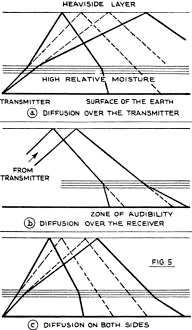|
February / March1932 Short Wave Craft
 [Table
of Contents] [Table
of Contents]
Wax nostalgic about and learn from the history of early electronics. See articles
from Short Wave Craft,
published 1930 - 1936. All copyrights hereby acknowledged.
|
This is the second
of a two-part article titled "How Are Short Waves Propagated?" The first part appeared
in the
December 1931/January 1932 edition of Short Wave Craft.
How Are Short Waves Propagated?
(Conclusion of Ferdinand Bödigheimer's article in last issue)
Uniformly dry air over transmitter and receiver seems to be the best
condition for good "DX" (distance) radiation (by day there is strong interference by increased
absorption). Conditions change with the increase in moisture in high strata above
the transmitter or receiver (formation of cirrus clouds). The "DX" possibilities
are then strongly limited; but close communication (say, over distances found in
Europe) is still possible at times. A high degree of moisture near the ground has
apparently little influence, if the air above is dry and uniform.

Fig. 5 - Assumed diffusion of energy by strata of high relative
moisture; normal course of radiation in dotted lines. For the sake of simplicity,
a straight course of radiation and reflection was drawn, instead of indicating refraction.
It is a matter as yet undecided, whether the relative moisture of the air or
the presence of a smooth surface (lack of uniformity) plays the decisive part. There
is much to be said for the latter assumption.
Appearances are such as to justify a hypothetical explanation as in Fig. 5.
One might assume that in the passage through unlike strata, a diffusion of the
radiation occurs. The sharp angle of the maximum radiation is broadened, the energy
accordingly diffused. One hears signals more weakly, but possibly in a much
wider zone. For "DX" distances the energy is weakened too much, if the diffusion
occurs directly over the transmitter, but for slight distances (Europe) it is still sufficient.
One hears from European distances more weakly than at the most favorable times;
but one hears at a time when one normally can" no longer expect close reception,
because of the movement of the zone of audibility, which has already occurred.
It is another matter when the diffusion occurs only over the receiver, while
the radiation is not limited over the transmitter. Then one can hear "DX" stations,
though to be sure not so well as at the most favorable times; but he can determine
that he hears at the same time from more countries, from far wider regions, than
in the case of "good DX weather." To be sure, there is then little prospect of successful
activity on the part of one's own transmitter. Naturally the conditions are worst
when diffusion occurs over both transmitter and receiver. The weather conditions
mentioned there-fore bring a widening of the zone and a reduction of receiving intensity.
The frequently-mentioned "air pressure" is of significance only so far as it plays
a part in the movement of air and, thereby, in the moisture conditions in higher
strata. The same statement holds for the temperature. Meteorological conditions
in the intermediate stretches are entirely of no moment. The radiation runs along
in strata of the atmosphere, which are far higher than those in which meteorological
processes occur (30 to 60 miles, compared with at most six miles, below the stratosphere,
in which conditions are" constant).
The energy diffusion by strata of high relative moisture at a rather great height
is, we must again insist, a theory, which is justified on the basis of the phenomena
observed. An explanation of how the energy diffusion occurs cannot yet be given.
Therefore I can as yet merely say: "It is as though . . ."
Therefore the broadcaster strives in vain, if he tries to improve the reception
of the ground wave, in this or a somewhat greater radius, as against the reception
of the space radiation of strong distant stations, by competition in the output
of energy. The improvement also strengthens the distant stations, and the zone of
"space radiation" is widened. Since the space radiation alone is in question in
distant reception, even on long waves, the formation of zones and their shifting,
together with the atmospheric conditions, can be perfectly observed in the case
of long waves.
Posted July 16, 2020
(updated from original post on 10/26/2015)
|










